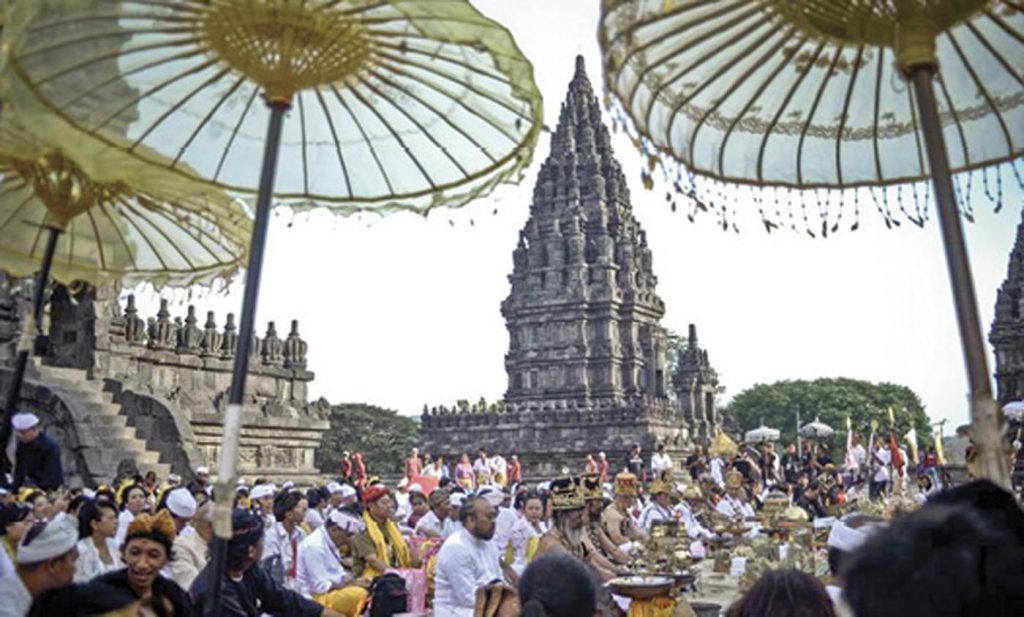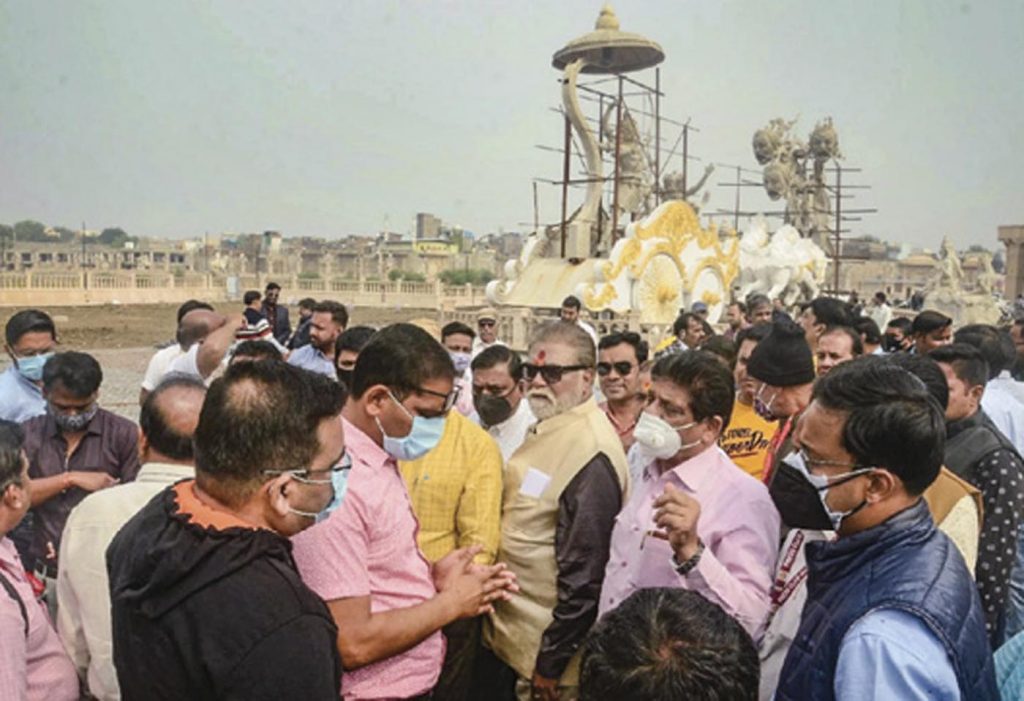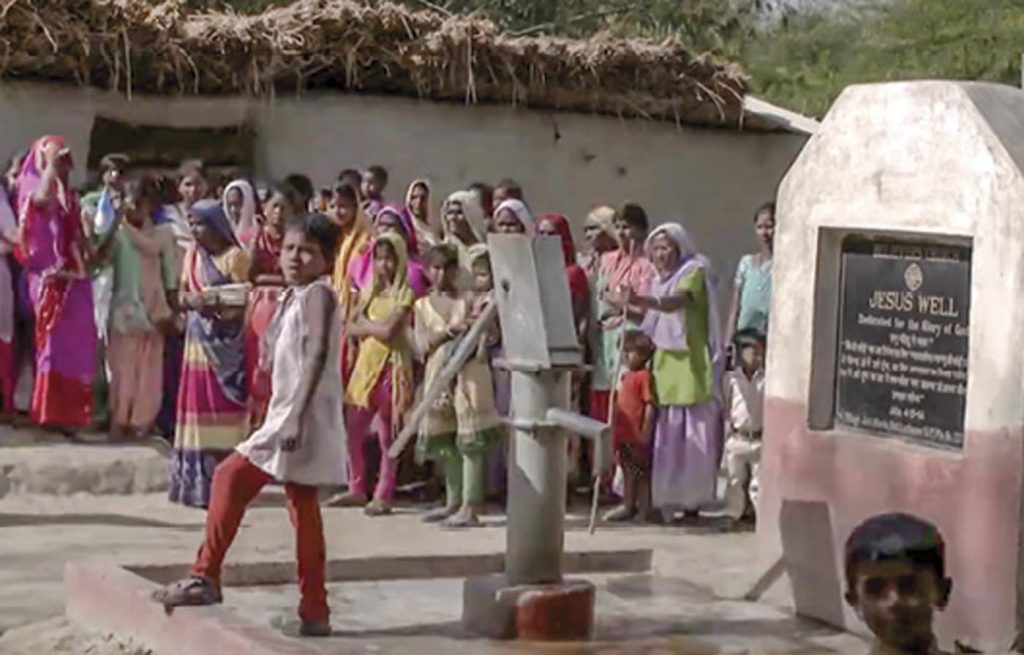Indonesia
Java’s Prambanan Temple Is Rededicated After 1163 Years


Hindus across Indonesia turned up in large numbers for a special abhisheka ceremony performed at Prambanan Temple November 12, 2021, according to a report in opindia.com. The ritual, preceded by two days of preparatory rites, was held to clean and purify the temple site for the first time in 1,163 years.
“Prambanan,” explains archeologist Manggar Sarl Ayuati, “is one of the largest Hindu temple complexes in Asia, with an enclosed area 390 meters on a side. It was built in 856 by King Rakai Pikatan of the Sanjaya dynasty, which ruled the Mataram Kingdom, and was expanded by later kings. It is dedicated to Siva.”
“After we discovered an inscription from the temple’s inauguration day—November 12, 856ce—stating what ritual was conducted, we decided to perform the same ritual now,” said Made Astra Tanaya, a member of the abhisheka committee.
Prambanan has three concentric courtyards. The innermost contains 16 temples, including the 156-foot-high main temple to Siva and 108-foot temples to Vishnu and Brahma. The second courtyard originally contained 240 small temples. Only 129 have been restored to any degree; the rest are just piles of rocks. No structures remain in the third courtyard. The complex also contains four Buddhist temples.
Prambanan was abandoned in the 10th century, likely when the Mataram kingdom moved due to a volcanic eruption which heavily damaged the temple and surrounding area.
India
Ujjain Temple Campus Swells


An $80 million USD upgrade to the ancient mahakaleshwar temple is more than 70% complete, freepressjournal.in reports. Lord Siva is worshiped here as “Great Time.” Land acquisition will increase the temple’s area from six acres to 40.5 and allow for expansion of the main road to 230 feet wide. Security facilities will be greatly improved, and include a watch tower to safeguard the complex. Other additions include a Rudrasagar laser show, electric rickshaws, accessibility ramps, a museum, parking, shoe and food stalls as well as dedicated media facilities. The entire temple, one of twelve Jyotirlinga temples of India, is to be powered by solar panels. New temple facilities will include a shrine with the 108 Tandava dance poses of Siva. After completion, the premises will accommodate 100,000 devotees at a time
Arts
Floor Art Protects the Home


Diwali is incomplete without beautiful and creative
rangoli designs, US-based artist Jugnu Verma recently told The New York Times. These decorations are usually drawn on the floor at the entry to one’s home, often using chalk and colorful powders. They ward off negative spirits and welcome devas. It is also a creative grounding ritual for hundreds of millions of women who create them daily. Ms. Verma says the focus involved “helps develop meditative power.” It’s OK if her designs are eaten by insects, trampled over by visitors, whisked away by wind or washed away by rain. That impermanence is part of the form’s beauty. Once only passed down from mom to daughter, now one can learn rangoli, and the similar Tamil kolam, online. Nowadays, fewer people perform this as a daily practice; and some are using paints so the design can last a few months to a year
USA
Nascent Hindu Chaplaincy


When Vineet Chander accepted his job as the Hindu chaplain at Princeton University in 2008, students were baffled. “It was incomprehensible to them,” said Chander in a report for Religion News Service. “I’d have people look at me like, what do you do? This is a full-time job?” Their puzzlement was understandable: Chander, a former prosecutor, was not just the only full-time Hindu chaplain at any place of higher learning at the time; he was the first Hindu in the US ever to fill the role. That was partly due to the small numbers of Hindu students.
Another factor is the title chaplain itself. While Hinduism recognizes the idea of spiritual caregiving, chaplaincy traditionally has been associated with Christian ministers and is not readily translated into a Hindu framework. “Hindus don’t often understand what chaplaincy is, and non-Hindus aren’t familiar with Hinduism,” said Asha Shipman, director of Hindu life at Yale University.
Universities hire chaplains through outside institutions such as mosques, synagogues and church councils. “Hindus don’t have such a resource.” In 2020 she and colleagues founded the North American Hindu Chaplains Association to change that. NAHCA will provide Hindus the theological training currently missing at US seminaries and universities, and develop a process for chaplains who want to become board certified.
Similarly, the Chinmaya International Foundation has two new online courses for training chaplains to serve across settings from hospitals to the military. For queries about these courses, email spiritualcare@chinfo.org.
According to Chander, in the US there are now at least five full-time Hindu chaplains in higher education, a dozen or so part-time Hindu chaplains and a much larger number of volunteers and affiliates.
Video
How Netaji’s Army Fought for India’s Independence in WWII


When Indian independence leader Netaji Subhash Chandra Bose fled for safety to Malaysia during World World II, his presence galvanized second- and third-generation Indian immigrants. “At the Altar of India’s Freedom—INA Veterans of Malaysia” is a 30-minute documentary capturing the stories of valor and sacrifice, plus the saga of the Malaysian Indians who, as teenagers, fought for India’s freedom with Japanese assistance from the distant lands of Southeast Asia. Many of them had never even seen India.
Created by journalist Choodie Shivaram of Bengaluru and produced by the High Commission of India in Malaysia, the film became available on YouTube after its debut screening in 2018 at Bharatiya Vidya Bhavan.
INA (Indian National Army formed by Netaji) veterans recall the impact that he had on their lives. Shivaram recounted to the Deccan Herald, “A woman I spoke to was married only for six months. She and her husband joined the INA and told themselves that they would meet each other if they are alive or it’s goodbye.” The INA’s young women formed the Rani of Jhansi Regiment, which was the first all-woman combat regiment in the world.
Even today, these INA veterans who are nonagenarians continue to live by the lofty ideals of Netaji. When the regiments on their way to Delhi had to return home after Japan surrendered, Netaji wrote to them, “Do not be depressed at our temporary failure. Be of good cheer and keep up your spirits. Above all, never for a moment falter in your faith in India’s destiny. There is no power on Earth that can keep India enslaved. India shall be free and before long.”
India
This Christian Doesn’t Feel Persecuted in His Motherland


Savio rodrigues is a christian in India who doesn’t agree with generalizations made in a recent New York Times article, “Arrests, Beatings and Secret Prayers: Inside the Persecution of India’s Christians.” In a opinion piece at firstpost.com, he shares that he faced vicious attacks online after questioning the veracity of a statement made by an archbishop from Delhi, who opined that “Christians are in danger in India.” Here are excerpts from Savio’s letter:
“The reason I disagree with some of the messages of the Catholic Church leaders is because while they think they are highlighting a growing concern for the Christians, which they should, the matter of a few cases of Christian persecution cannot be generalized to be the plight of all Christians in India.
“Sadly, through their statements, Church leaders target the Narendra Modi-led BJP government that is portrayed as a Hindu majority political party. But in all fairness, Prime Minister Modi and BJP are not the problem; it is the conversion effort that is the real trigger to the disharmony between Christians and Hindus in India. Religious freedom is every citizen’s constitutional right. You are free to live your faith in India as long as you respect the faith of other citizens. Proselytizing the Christian faith while demonizing Hindus and Hindu faith is against the very Constitution that gives you the freedom to profess your Christian faith in India.
“The recent attacks by mobs that see themselves as the torchbearers of Hindu beliefs must be condemned and authorities must act against such acts of religious intimidation and brutish behavior. Similarly, authorities must also act against those Christian missionaries who commit acts of religious intimidation and coercion to convert Hindus to Christianity.
“Mocking and deriding Hindu beliefs is the fulcrum around the missionary activities of some of the Christian organizations. They are exploiting the lacunas present due to some social anomalies in Indian society. They see it as a doorway to undertake their religious conversion agenda.
“Christian conversions and prayer healing services have mushroomed across the country. Some pastors openly insult Hindu religious beliefs. Mohan Lazarus, in a 2018 preaching service, called Hindu temples ‘Satan’s strongholds.’
“It is wrong to term the conflict in India arising out of the growing concern over conversions and demonization of Hindu beliefs by the Christian missionaries as persecution of Christians. This sort of generalization further creates a divide between the two religious communities. Hindus, just as Christians, have every constitutional right to protect their religion under the laws of the land.”
Briefly…
India’s Uttarakhand State government scrapped a plan, in November 2021, to bring the management of 51 temples, including the four of the Char Dham pilgrimage, under government board control. The priest community has welcomed the reversal, hailing the decision to restore “Hindu tradition and rituals.” Gangotri-based priest Rajnikant Semwal said, “From day one, we have been asking why, if the state government has no control over the management of churches or mosques, it is pushing hard to take over temples.”
During the convocation ceremony of Skanda Guru Vidhyalayam priest training school, in Thirupparankundram, Tamil Nadu, in October, 2021, Dr. Sabharathnam Sivachariar was conferred the title of Sakalakama Pandit—“Expert in all Agamas.” The award was presented on that occasion by the head pontiff of Dharmapura Aadheenam and includes a cash award of US$1,350. The presentation was made in the presence of the school principal, Raja Bhattar, Karumuthu Kannan of Meenakshi Sundareshwarar temple and many priests and students.
The Hindu American Foundation offers two new resources at hinduamerican.org: 1) a revamped Diwali toolkit which has more information about why the festival is celebrated, and lesson plans for the classroom and home activities; 2) a three-year calendar of Hindu, Sikh, Buddhist and Jain holidays, along with brief explanations of each and links to additional reading materials.
India’s Prime Minister Narendra Modi inaugurated a key part of Varanasi’s Kashi Vishwanath Corridor in December, 2021. Constructed in less than three years at a cost of US$44.7 million, the corridor connects the various ghats (stepped bathing areas along the riverbank) to the historic Kashi Vishwanath Temple. It aims to provide easy access for pilgrims to take a bath in Ganga and then offer their prayers to Lord Siva.
The Ayodhya Ram Temple foundation was completed in September 2021. It is a whopping 50 feet thick, 400 feet long and 300 feet wide, covering nearly three acres. The technically sophisticated foundation, made of roller-compacted concrete comprised of fly ash, gravel and cement in successive layers of one foot each, will be able to support the immense weight of the temple without settling. Officials say the temple’s sanctum sanctorum will be opened to pilgrims by December 2023—quite an ambitious goal.


